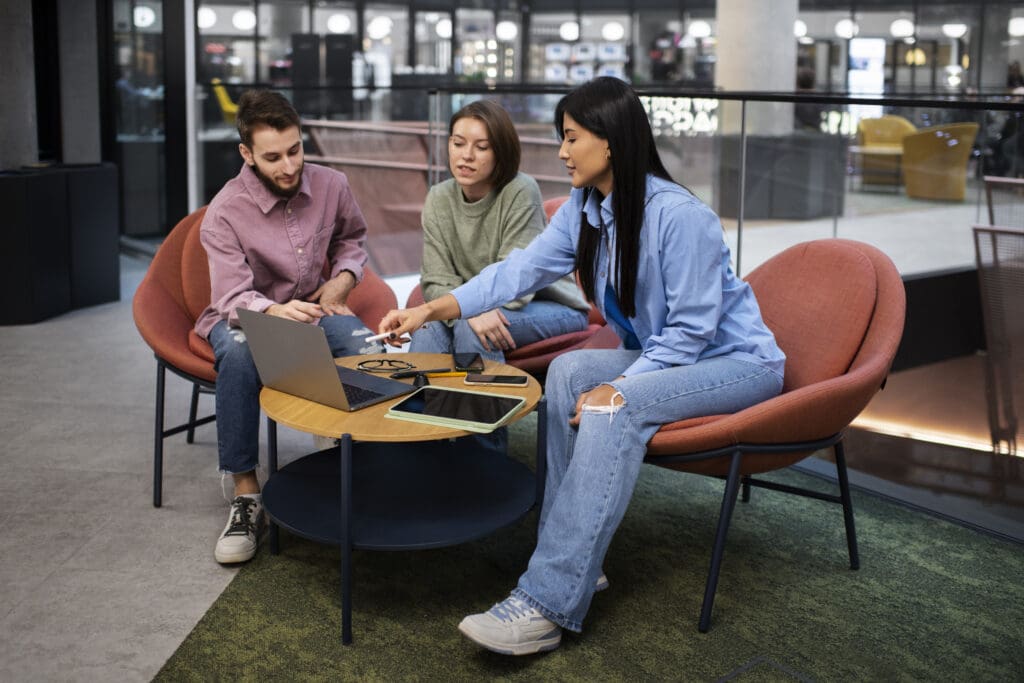Ever since we were hit by the pandemic, we realized that many of our jobs can be reduced to a few emails, meetings and phone calls. Technology has brought us closer across distances, and it took a global pandemic to show us just how much. Moreover, many corporations realized that work from home was a good way of saving company resources.
Employees, on the other hand, realized that working from home was a great way of avoiding daily commute and spending more time with their family. So everything was chalked out, remote work opportunities were growing in number- yet there is a dark side to this arrangement.
Work life balance takes a hit when you work from home. You have no physical and mental boundaries between work and home, and the stress from one situation spills over into another. You get out of bed and go straight to the desk- there’s no time to make the mental transition from home to work.
Fortunately, there is a solution to this problem- co-working spaces. These are like small cafes or offices where people sign up to come and work together. They may work on individual tasks or collaborate on projects.
Why co-working spaces are popular
Digital nomads, entrepreneurs and freelancers from various professions find co-working spaces perfect for their needs. So on one hand, you don’t have to commute to your main office, and at the same time, you don’t have to force your work into your living space. In fact, many offices buy leases on co-working spaces so that employees can benefit from a membership.
Tan and Lau (2020) studied people’s motivation behind joining a co-working space. They found that convenient location, open space layout, shared facilities, and knowledge sharing were some of the factors behind their decision to be a member in a co-working space.
Networking opportunities

A co-working space is not exactly an office. You have co-workers, rather co-members, but they don’t necessarily fall into a hierarchy. You are mostly free to approach whoever you want- be it in the workspace, or in the cafeteria after work. Budding entrepreneurs meet experienced consultants, talent hunters find promising candidates, young professionals find mentors, and so on.
Collaborations

As I said earlier, a big advantage of co-working spaces is that they are open for everyone, regardless of background. As long as you pay the membership fees, you are in. How often do you find accountants and designers sitting next to each other? How often does a financial adviser have lunch with a PR consultant? Departments collaborate, teams are built, and interdisciplinary ideas take flight in a co-working space.
Casthilo and Quandt (2017) identified four dimensions of collaboration in a co-working space- enabling knowledge sharing, enhancing a creative field, enhancing an individual action for the collective, and effectively supporting the implementation of a plan.
Dark side of co-working spaces
Every coin has two sides. Co-working spaces sound like the perfect solution to modern workspace problems- but they come with their own drawbacks.
Cost and work hours
Some co-working spaces hike up membership fees at unreasonable rates. In fact, you may feel like commuting to work is economically more viable than paying for a co-working space. In that case, it is a completely sensible decision to drop the idea of a co-working space.

Some spaces are only open during standard business hours during the day. For employees who work with overseas clients, take late night calls and coordinate across time zones, some co-working spaces might not be inclusive of their needs.
These problems apply to only certain co-working spaces. Of course, there are options out there. Don’t let a few places ruin your perception of the concept entirely. Take your time, and explore options until you find the best fit.
Adjustment issues
A co-working space is owned by the company who runs it. They design the interiors, hire the staff, maintain the space and make decisions about membership. You can’t make any changes to the space, unless the owner is very proactive about user feedback.

Moreover, some spaces might require you to pay extra to access certain spaces like meeting rooms, extra tables, kitchen facilities, etc. While this arrangement allows people to opt out of certain services to cut costs, some people find this extremely inconvenient.
Peer competition
Some co-working spaces screen applicants before onboarding them as members. Others don’t really bother, as long as the fees are paid. It is very likely that you might run into a competitor, or a bitter rival. Even if you don’t know them personally, it’s quite a tense experience to work in the presence of someone who is competing for the same set of clients and market.
Distractions
Co-working spaces are, in a way, meant to help you focus. Being surrounded by people working for a common project boosts motivation. Sometimes, people pair up with a desk buddy and they motivate each other to focus on their individual tasks.

It all depends on the people- so things could also go wrong. You might find yourself trying hard to read a spreadsheet while people take their lunch break in the background. Some spaces have designated quiet zones, brainstorming couches, meeting rooms and so on. But otherwise, distraction is a very real obstacle to your productivity.
Strategies for success
If you want to make the most out of your co-working experience, the first, and most important step, is to select the right place. Have a clear understanding of your needs, and ask yourself- will this space fulfill the must-haves, the deal breakers? What are the things that are crucial to your work day? If those needs are not being met, it’s time to jump ship.
Apart from that, there are certain things that are beyond your control- for example, you can’t predict the membership changes that will happen over the course of time. People come and go- and the social atmosphere keeps changing. Here’s what you can do to make sure that you have a decent experience in the face of constant change.
- Effective communication- If something bothers you, set up a time and place, and talk it out with the concerned party
- Building relationships- When you meet like minded professionals, put effort in networking. Maintain contact with people who make your day better.
- Setting boundaries- Clearly demarcate your time for informal socialization and focused work. It is easy to lose track of time when you are your own boss.
If you are a co-working enthusiast, I hope this article helped you get an unbiased perspective on co-working spaces. At the end of the day, your needs are important, and any space you choose- be it a traditional office, your home desk, or a co-working café- should complement your workflow.


GIPHY App Key not set. Please check settings